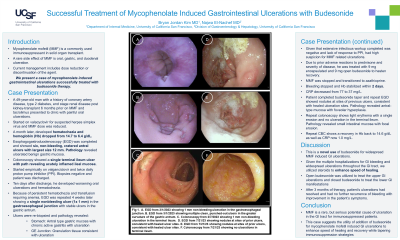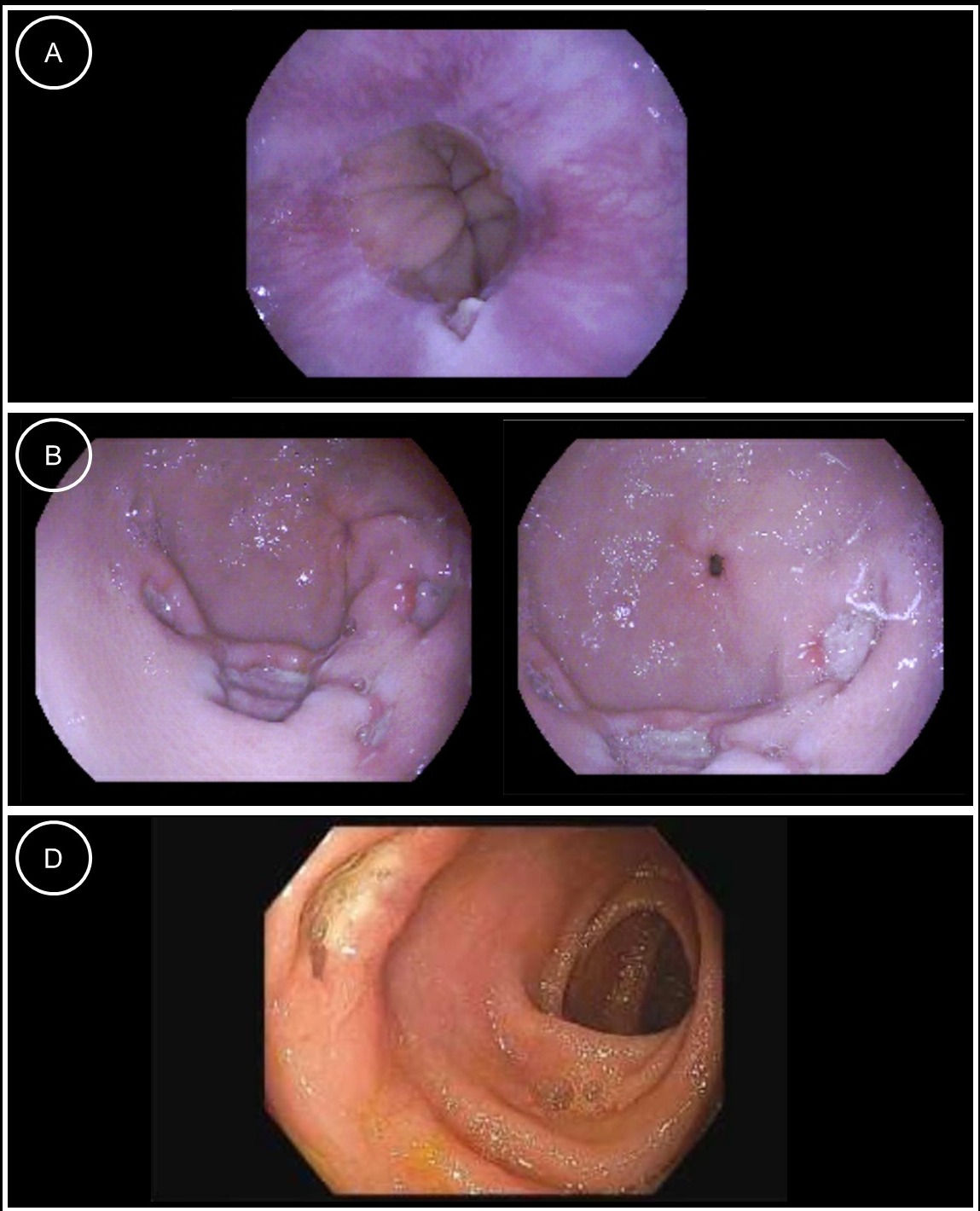Tuesday Poster Session
Category: GI Bleeding
P3478 - Successful Treatment of Mycophenolate Induced Gastrointestinal Ulcerations with Budesonide
Tuesday, October 24, 2023
10:30 AM - 4:00 PM PT
Location: Exhibit Hall

Has Audio

Bryan J. Kim, MD
University of California, San Francisco
San Francisco, CA
Presenting Author(s)
Bryan J. Kim, MD, Najwa El-Nachef, MD
University of California, San Francisco, San Francisco, CA
Introduction: Mycophenolate mofetil (MMF) is commonly used in solid organ transplantation. One of the rarer side effects of MMF is gastrointestinal (GI) ulceration. We describe a case of MMF-induced ulceration successfully treated with budesonide therapy.
Case Description/Methods: A 49-year-old male with a history of coronary artery disease, type 2 diabetes, end-stage renal disease post kidney transplant 6 months prior on MMF and tacrolimus presented to the clinic with painful oral ulcerations. He was started on valacyclovir for suspected herpes simplex virus and the MMF dose was reduced. A month later, he developed hematochezia and hemoglobin dropped from 14.7 to 6.4 g/dL. He was admitted for transfusion, esophagogastroduodenoscopy (EGD), and colonoscopy. EGD was remarkable for six, non-bleeding, cratered antral ulcers (largest size 12 mm) while colonoscopy was remarkable for a single terminal ileal ulcer. Given the appearance of lesions and history of donor cytomegalovirus (CMV) positivity, he was started empirically on valganciclovir and twice daily proton pump inhibitor (PPI). Pathology was negative for viropathic changes and he was discharged home.
Ten days after discharge, he developed worsening oral ulcerations and hematochezia. EGD was repeated 4 weeks after the initial EGD and found a single non-bleeding ulcer 1 x 1 mm in the GE junction with stable ulcers in the gastric antrum. Ulcers were re-biopsied; pathology and extensive infectious workup were unremarkable. Given the persistence of ulcers despite PPI therapy and negative infectious workup, he was diagnosed with MMF-induced ulcerations. MMF was discontinued with the transition to azathioprine. Due to prior adverse reaction to prednisone, he was treated with encapsulated and open budesonide to hasten recovery. His bleeding stopped within 2 days of budesonide and his CRP decreased from 77 to 37 mg/L. He is currently undergoing budesonide taper with improved symptoms with planned EGD for monitoring after completion.
Discussion: This case describes the novel use of budesonide for MMF-induced GI ulcerations. Treatment of MMF-induced ulcerations has involved tapering the dose or switching immunosuppression. Our strategy for this patient included the use of steroids to enhance the speed of healing given multiple hospitalizations for GI bleeding. This case shows the utility of the addition of budesonide to improve symptoms of MMF-induced ulceration.

Disclosures:
Bryan J. Kim, MD, Najwa El-Nachef, MD. P3478 - Successful Treatment of Mycophenolate Induced Gastrointestinal Ulcerations with Budesonide, ACG 2023 Annual Scientific Meeting Abstracts. Vancouver, BC, Canada: American College of Gastroenterology.
University of California, San Francisco, San Francisco, CA
Introduction: Mycophenolate mofetil (MMF) is commonly used in solid organ transplantation. One of the rarer side effects of MMF is gastrointestinal (GI) ulceration. We describe a case of MMF-induced ulceration successfully treated with budesonide therapy.
Case Description/Methods: A 49-year-old male with a history of coronary artery disease, type 2 diabetes, end-stage renal disease post kidney transplant 6 months prior on MMF and tacrolimus presented to the clinic with painful oral ulcerations. He was started on valacyclovir for suspected herpes simplex virus and the MMF dose was reduced. A month later, he developed hematochezia and hemoglobin dropped from 14.7 to 6.4 g/dL. He was admitted for transfusion, esophagogastroduodenoscopy (EGD), and colonoscopy. EGD was remarkable for six, non-bleeding, cratered antral ulcers (largest size 12 mm) while colonoscopy was remarkable for a single terminal ileal ulcer. Given the appearance of lesions and history of donor cytomegalovirus (CMV) positivity, he was started empirically on valganciclovir and twice daily proton pump inhibitor (PPI). Pathology was negative for viropathic changes and he was discharged home.
Ten days after discharge, he developed worsening oral ulcerations and hematochezia. EGD was repeated 4 weeks after the initial EGD and found a single non-bleeding ulcer 1 x 1 mm in the GE junction with stable ulcers in the gastric antrum. Ulcers were re-biopsied; pathology and extensive infectious workup were unremarkable. Given the persistence of ulcers despite PPI therapy and negative infectious workup, he was diagnosed with MMF-induced ulcerations. MMF was discontinued with the transition to azathioprine. Due to prior adverse reaction to prednisone, he was treated with encapsulated and open budesonide to hasten recovery. His bleeding stopped within 2 days of budesonide and his CRP decreased from 77 to 37 mg/L. He is currently undergoing budesonide taper with improved symptoms with planned EGD for monitoring after completion.
Discussion: This case describes the novel use of budesonide for MMF-induced GI ulcerations. Treatment of MMF-induced ulcerations has involved tapering the dose or switching immunosuppression. Our strategy for this patient included the use of steroids to enhance the speed of healing given multiple hospitalizations for GI bleeding. This case shows the utility of the addition of budesonide to improve symptoms of MMF-induced ulceration.

Figure: Figure 1: A. EGD from 3/1/2023 showing 1 mm non-bleeding ulceration in the gastroesophageal junction. B. EGD from 3/1/2023 showing multiple clean, punched-out ulcers in the greater curvature of the gastric antrum. C. Colonoscopy from 2/7/2023 showing 1 mm non-bleeding ulceration in the terminal ileum
Disclosures:
Bryan Kim indicated no relevant financial relationships.
Najwa El-Nachef: Federation Bio – Advisor or Review Panel Member. Ferring Pharmaceuticals – Advisory Committee/Board Member.
Bryan J. Kim, MD, Najwa El-Nachef, MD. P3478 - Successful Treatment of Mycophenolate Induced Gastrointestinal Ulcerations with Budesonide, ACG 2023 Annual Scientific Meeting Abstracts. Vancouver, BC, Canada: American College of Gastroenterology.
